51 Types of Flowering Weeds (with Pictures): Identification Guide
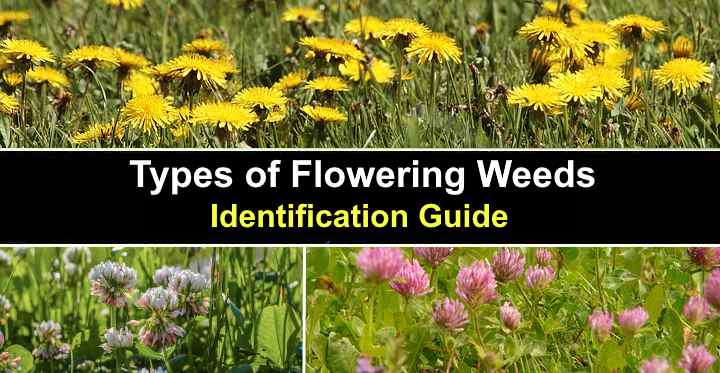
Despite weeds having a bad rap, flowering weeds can add a touch of natural beauty, color, and fragrance to your garden landscape. In the right place, weeds that flower don’t have to be a nuisance. Instead, flowering weeds with white, purple, or pink flowers can bloom and enhance the visual appeal of your yard. After all, what may be a weed to one gardener could be an attractive flower to another.
Of course, no one wants white-flowering weeds like white clover or chickweed spoiling the appearance of a lush, green lawn. And many weedy plants have invasive properties, meaning they will proliferate and spread where you don’t want them. So, knowing how to get rid of weeds is crucial for maintaining an attractive front or backyard.
This article highlights common types of flowering weeds that have white, purple, yellow, or pink flowers. Descriptions and pictures of the weeds will help you identify them.
What Are Flowering Weeds?
Flowering weeds are typically plants growing in the wrong place. Although there is no botanical classification for a “weed,” the term typically applies to flowering plants that grow without you planting them. Flowering weeds tend to reproduce aggressively and spread uncontrolled outside their native habitat.
Many species of flowering plants that some consider weeds are beneficial weeds. For example, yellow flowering weeds like dandelions help to facilitate healthy soil and also help to support the pollinator populations. In addition, some weedy plants with white flowers like chickweed or purple-flowering weeds like chicory have edible parts.
How to Identify Flowering Weeds
Looking at the shape and color of the blooms is the easiest way to identify flowering weeds. Weed flowers can be spherical heads with small colorful petals, star-shaped or funnel-shaped flowers, or small flowering spikes. In addition, flowering weeds are identified by their roots—taproots, creeping rhizome roots, or fibrous roots.
Types of Flowering Weeds (with Pictures): Identification Guide
Here’s a list of common flowering weeds, starting with white flowering weeds.
Weeds with White Flowers (with Pictures): Identification Guide
Weeds with white flowers are so common that you probably don’t think about them. That is until the tiny white flowers in the grass appear or start taking over your flower beds. Let’s look in detail at weeds with white flowers common in gardens.
Mouse-Ear Chickweed (Cerastium)
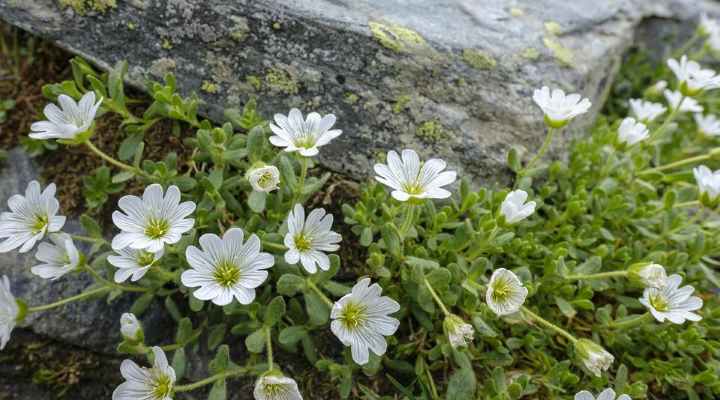
Mouse-ear chickweed is identified by its little white flowers and small hairy leaves and has a spreading habit
Mouse-ear chickweed is an annual weed with small fuzzy green leaves and tiny white star-shaped flowers. The white flowers on the wild plants have five deeply notched oblong petals creating a cup shape. Each white flower measures about 0.25” (0.6 cm) across. Mouse-ear chickweed grows 0.5 to 1.5 ft. (15 – 45 cm) tall.
Mouse-ear chickweed has easily identifiable oblong or egg-shaped leaves. The small hair-covered leaves measure 0.33” to 1” (0.8 to 5.2 cm) long. The leaves and white flowers grow on fuzzy stalks and spread across the ground.
Mouse-ear chickweed is a mat-forming, quickly spreading white-flowering plant. If left alone, chickweed will quickly form dense patches of green leaves. The white daisy-like weed flowers bloom from May through September.
Common Yarrow (Achillea millefolium)
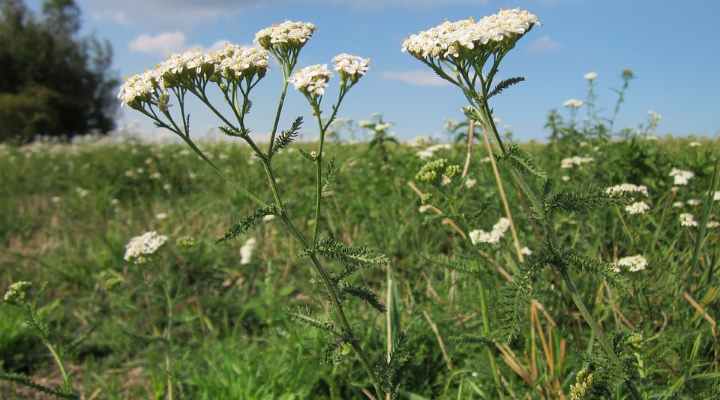
The flowering common yarrow weed produces white flat-topped flowers and it has feathery leaves
Common yarrow is a tall white-flowering weed with large flat-topped clusters of tiny creamy-white flowers. The huge white flower clusters grow at the end of tall stems. An identifying feature of weedy yarrow is its feathery, fern-like leaves growing on the erect stems. Yarrow grows 2 to 3 ft. (0.6 – 1 m) tall.
Although common yarrow has weed-like qualities, it has plenty of ornamental features for growing in a sunny garden. It thrives in wet and dry soils and doesn’t need much care to thrive. It is also a long-blooming plant with attractive white flowers.
The attractive qualities of yarrow mean that many people tolerate the beneficial weed in yards as an easy-care perennial ground cover.
Garlic Mustard (Alliaria petiolata)
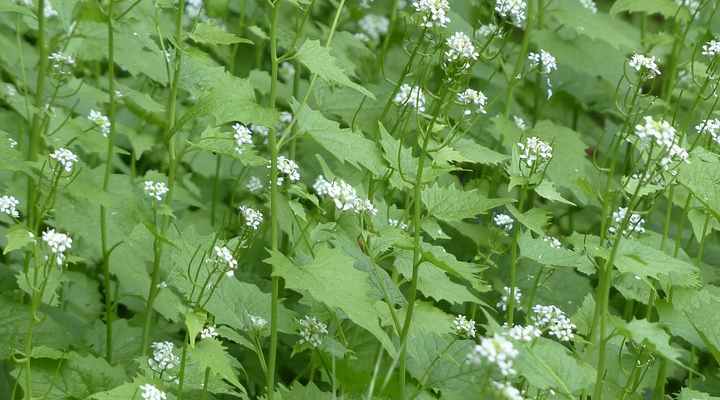
Garlic mustard has tiny white flowers sitting atop a tall slender stems and edible leaves
Garlic mustard is a weedy plant with tall, slender stems topped with tiny white flowers that bloom from late spring to early summer. The herbaceous plant has triangular leaves with coarsely toothed margins. Its white flowers form small clusters of pure white petals, with four rounded petals comprising a single flower. Garlic mustard can grow up to 3 ft. (1 m) tall.
The weedy nature of garlic mustard is due to the proliferation of seeds it produces. These tiny seeds scatter far from the plant and sprout easily in most soil types.
Garlic mustard can be considered a beneficial weed. Despite its weedy growth, its tiny white flowers attract pollinators in spring and summer. In addition, the dark green heart-shaped leaves are edible and can be used to add a spicy garlicky-mustard tang to salads.
Japanese Knotweed (Reynoutria japonica)
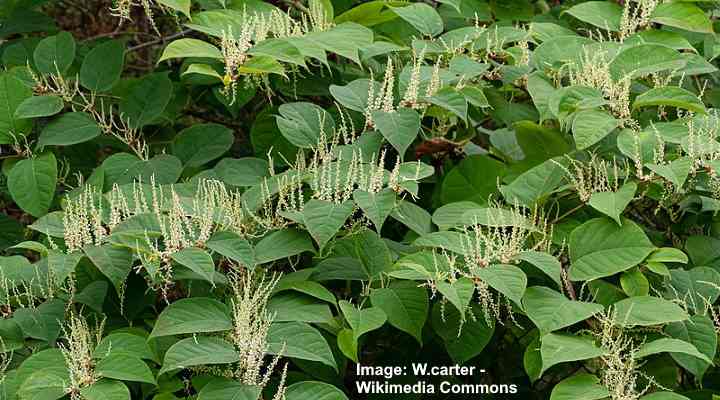
Japanese knotweed can be identified by its creamy white flower spikes and heart-shaped leaves
Japanese knotweed is a rapidly spreading, clump-forming weed with large heart-shaped leaves and slender creamy white erect flower spikes. The weedy plant spreads through rhizomes deep in the ground. Although the weed dies back every year, it grows fast and can reach up to 7 ft. (2.1 m) tall.
The yellowish-white or dull white flowers appear on small spikes in late summer and early fall. New leaves emerge dark red on reddish-purple shoots and can grow up to 5.5” (14 cm) long. The creamy-white flowering spikes grow 6” (15 cm) tall.
Types of White Flowering Weeds in Lawn (With Pictures) – Identification
Weeds with white flowers can easily affect the appearance of a well-kept lawn. After spending time and money fertilizing a lawn, the last thing you want to see is small white flowers in the grass. Here are some of the most common white-flowering lawn weeds.
White Clover (Trifolium repens)
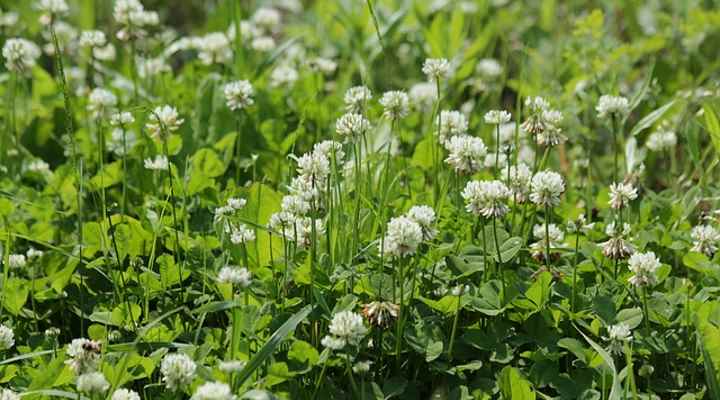
White clover produces creamy white flowers and spreads through the grass
White clover is a common perennial lawn weed with rich green leaves and masses of spherical heads of creamy-white flowers. White clover becomes a weed when it spreads rapidly via creeping stems. The dark green tear-shaped leaves grow in groups of three, and the white flowers bloom from spring through fall.
White clover is a weedy plant loved and despised by gardeners. It grows 4” to 6” (10 – 15 cm) tall and spreads aggressively from freely-rooting stems up to 1 ft. (30 cm). In many states, the plant is considered an invasive weed.
However, white clover has several benefits to a garden. For example, you can grow it to prevent soil erosion or plant it on slopes as clover grass where traditional turfgrass won’t grow.
The best way to prevent white clover from taking over lawns is to ensure your lawn is healthy. Also, it’s best not to mow turfgrass too short because white clover weeds thrive in shorter grass.
Related reading: How to grow a clover lawn.
Common Chickweed (Stellaria media)
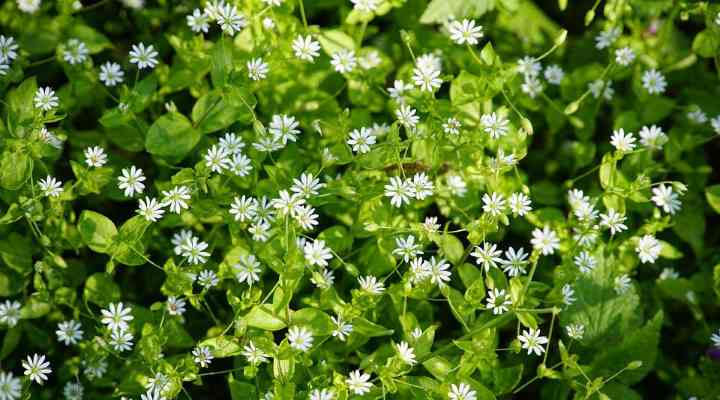
Common chickweed is an invasive plant with small white flowers that spreads through the lawn
Common chickweed is a sprawling weed with small white flowers that bloom in spring. The weedy plant is identified by its small, white spring flowers consisting of five deeply-lobed petals. Additionally, small, green, oval-ovate leaves growing oppositely up the stems create a dense mat of foliage.
Chickweed has white flowers that are unusual because the five delicate petals appear as ten petals. Apart from its invasive spreading properties, chickweed produces hundreds of seeds that get easily distributed over large distances.
Common chickweed is a significant white-flowering lawn weed. The tiny white flowers and thickets of foliage can quickly ruin the appearance of lush turfgrass. Chickweed grows up to 1.5 ft. (0.45 m) tall.
Daisy (Bellis perennis)
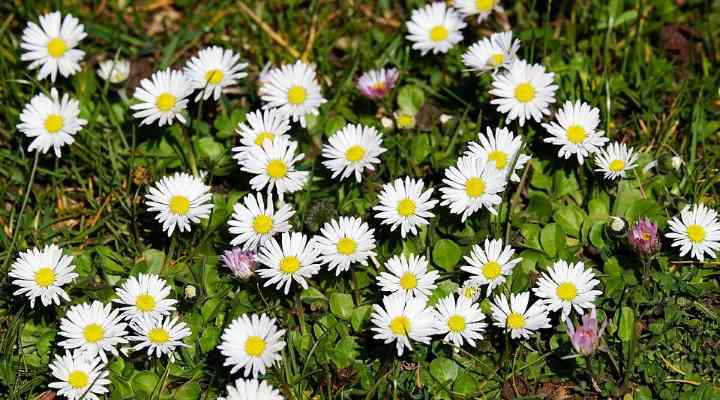
The white flowering daisy can become a weed when it aggressively invade lawns
Daisies are considered beautiful white flowers until they start growing in the grass. However, white daisies become a lawn weed when they take root in turfgrass and spread aggressively via rhizome roots. The white-flowering weedy plant has flowers with white oblong petals in a ray formation surrounding a yellow disc.
Identifying features of daisies are their characteristic white and yellow round flowerheads and spoon-shaped leaves growing flat to the ground. Clump-forming daisies grow 8” (20 cm) tall. Their leaves are 0.75” to 2” (2 – 5 cm) long, and the flowers are up to 1.25” (3 cm) in diameter.
White lawn weeds like daisies can be difficult to eradicate from lawns. It can seem that when you get rid of them, the white flowers in the grass start growing the following season again.
Bindweed (Calystegia sepium)
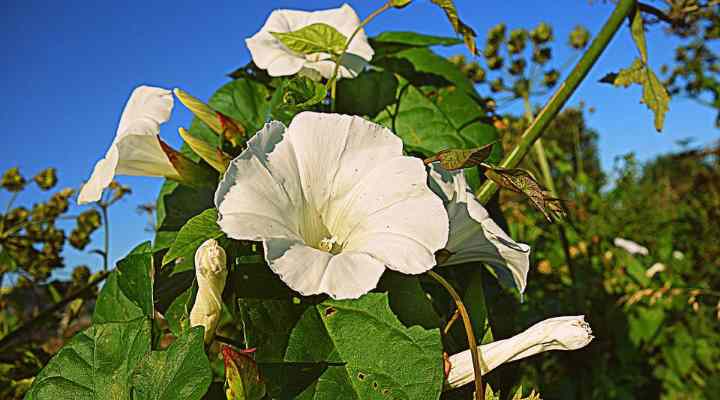
Bindweed has large showy white flowers but is a true weed that spreads quickly through its large root system
Also called hedge bindweed, this weedy vining plant is identified by its large white trumpet-like flowers. Bindweed is a true weedy plant because of its ability to spread quickly, twine around other plants, inhibit the growth of native plants, and has a robust root system.
Also called bellbind, twining bindweed grows up to 13 ft. (4 m) long and has arrowhead-shaped leaves and showy white flowers. Unfortunately, the issue with bindweed as a noxious white-flowering lawn weed is its extensive root system spreading up to 10 ft. (3 m). The weedy vine with white flowers can cause bare patches on lawns as it chokes out native turfgrass.
Black Nightshade (Solanum nigrum)
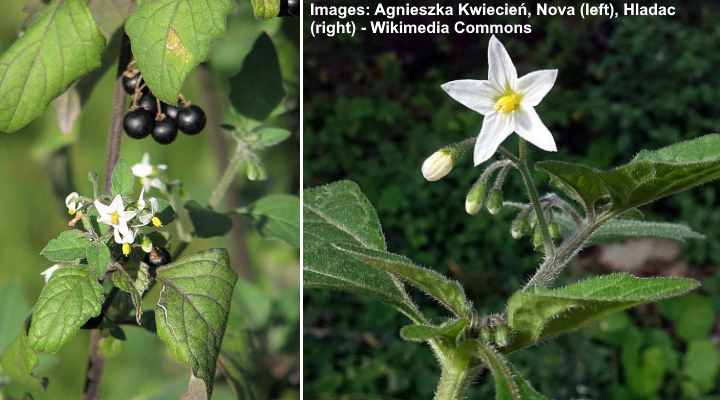
The annual black nightshade is characterized by a small white star shaped flowers
Black nightshade is a white-flowering annual plant with weedy tendencies. The dense shrub spreads prolifically and is characterized by its tiny star-shaped white flowers, green oval leaves, and small, black or purple, berry-like fruits. Other identifying features are the purple undersides of the leaves and hairy, stout stems.
Black nightshade grows 1 to 4 feet (0.3 – 1.2 m) tall. The noxious, poisonous weed thrives in coastal areas, wetlands, sandy soils, and along roadsides. Its invasive nature means it quickly competes with native crops and vegetation. However, some people grow black nightshade shrubs for their ornamental value.
Although black nightshade is a poisonous white-flowering weedy plant, it’s not as toxic as deadly nightshade (Atropa belladonna). You can tell the shrubs apart because black nightshade black berries grow in clusters, not individually.
Common Nettle (Urtica dioica)
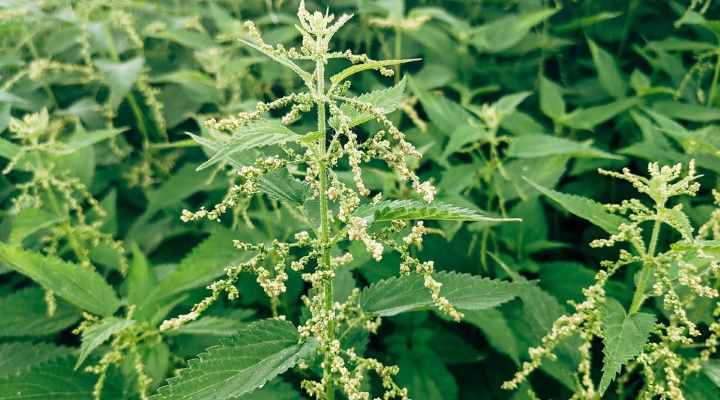
Stinging nettle weeds have spikes of inconspicuous creamy-white flowers
Common nettle is a stinging, weedy plant with small clusters of inconspicuous white flowers. Also called burn nettle, identifying features of the plant are its soft green, heart-shaped leaves with serrated margins, stinging hairs, and flowering spikes with yellowish-green flowers. The weed thrives in moist environments, waste areas, and disturbed ground.
Nettle stings are caused by tiny urticating hairs that puncture the skin. The hairs then release histamine, which causes welts and mild to severe itchy skin reactions. Common nettle is a prolific weed because it thrives in shaded areas and tolerates most soil conditions.
Common nettle grows 3 to 7 feet (1 – 2.1 m) tall and spreads by underground rhizomes.
Queen Anne’s Lace (Daucus carota)
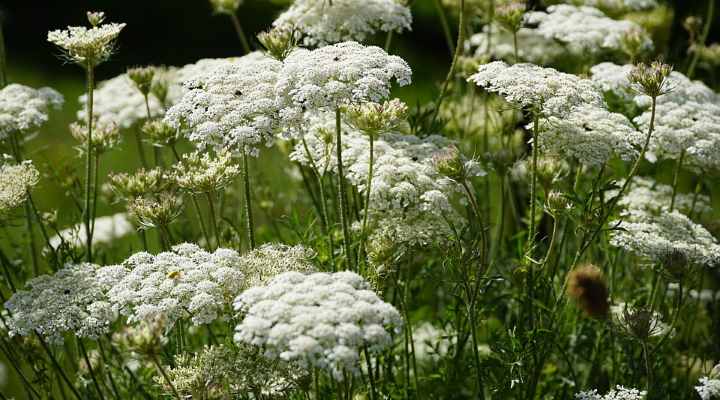
Queen Ann’s lace is an invasive weed with flat topped white flower clusters
Queen Anne’s lace is a biennial weed that produces a delicate and intricate cluster of small white flowers from late spring through to the early days of summer. The weed also features a basal rosette consisting of arching leaves 5” (13 cm) long.
The flowers attract pollinators such as bees and butterflies, contributing to the biodiversity of the surrounding ecosystem. These flowers are arranged in a flat-topped, lacy umbel shape, reminiscent of an intricate white doily. Despite being classed as a weed, the small white flowers look attractive when growing in flat-topped umbels 4” (10 cm) wide.
This invasive weed commonly grows along roadsides in sun or partial shade. It adapts well to most soil conditions, and its long taproot makes it difficult to eradicate. It also self-seeds easily, making it an aggressive spreading weed. It also tolerates freezing temperatures and extreme heat, thriving in USDA growing zones 4 to 11.
American Pokeweed (Phytolacca americana)
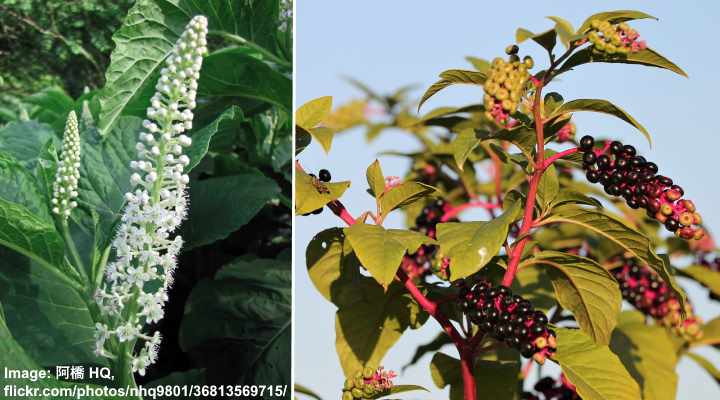
The flowers of American pokeweed grow in elongated clusters called racemes that appear in early summer until early fall
American pokeweed is a tall, weedy plant that spreads aggressively by self-seeding. The weed is identified by its small white summer flowers, long, lance-shaped leaves, and striking spiked clusters of dark purple berries. Once established, pokeweed is difficult to eradicate due to its thick taproot and underground rhizomes that spread vigorously.
Pokeweed can be a striking addition to native wildflower gardens. It has attractive reddish-purple stems, and its berries attract birds. However, all parts of the plant—the berries, leaves, and roots—are toxic. Also, it can quickly get out of control if not managed correctly. Additionally, its bright green leaves emit an unpleasant odor when crushed.
Curled Dock (Rumex crispus)
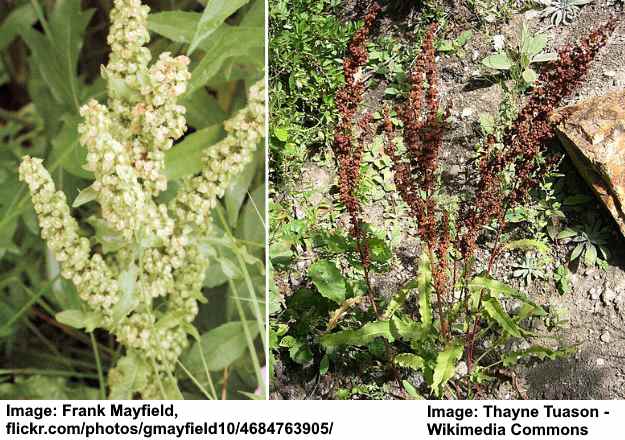
Curled dock creamy-white flowers (left) and reddish-brown seed capsules (right)
Curled dock is a long-lived, weedy perennial identified by its conical clusters of greenish-white flowers. The weed has long, curly, lanceolate leaves on tall, erect stems. After flowering, the curled dock produces reddish-brown seed capsules in a tear shape. The medium-sized weed grows 2 to 3 ft. (0.6 – 0.9 m) and has robust, upright stems.
Curled dock grows in the wild in open fields, meadows, along roadsides, and wastelands. However, it can become a nuisance weed if it gets into gardens. It’s difficult to eradicate because it thrives in most soil types and tolerates flooding and dry conditions. Also, its seeds can remain viable for up to 50 years.
Wild Madder (Galium mollugo)

The white flowering wild madder is a quick spreading weed through its small seeds
Wild madder is a weed with white flowers that grow on slender, square stems. A feature of this vigorous weed is its small lance-shaped leaves arranged in whorls around the stem. The four-petalled, star-shaped flowers are whitish-green and grow in dense clusters.
Wild madder grows up to 4 ft. (1.2 m) tall. However, its vine-like growth allows it to spread vigorously along the ground. After flowering, the weed produces small, round seed capsules covered in bristly hairs, aiding in seed dispersal. Wild madder thrives in well-drained soils in sunny or partially shaded locations.
Wild madder is native to Europe but has naturalized in various parts of North America. In most places, it’s considered an invasive weed. The best way to remove the noxious weed is to pull up the roots before it produces seed.
Quickweed (Galinsoga parviflora)
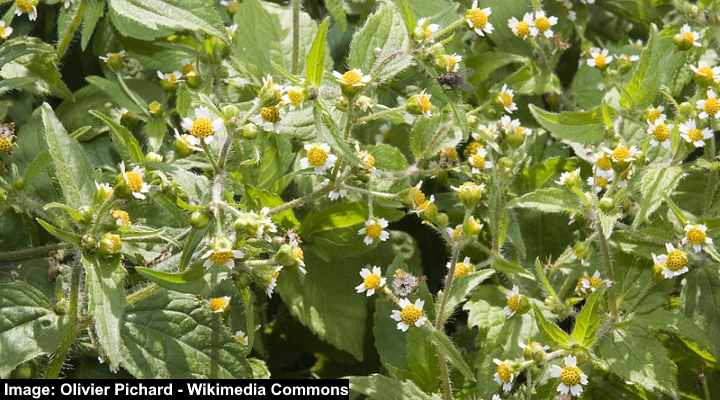
Quickweeds spread aggressively and are identified by their tiny white flowers with white centers
Quickweed is an herbaceous weed characterized by tiny white daisy-like flowers. The weed’s flowers consist of three to eight florets surrounding a central yellowish disk. The small white flowers bloom throughout the summer. Other features of the aggressive weed are its branching stems with serrated leaves and fast-spreading nature.
Quickweed is a fast-growing plant that can quickly take over an area if left unchecked. It can grow up to 2 ft. (0.6 m) tall. Its weedy nature comes from its ability to spread through seed. Therefore, it easily reestablishes itself if not completely removed.
To prevent regrowth, controlling quickweed requires removing the entire plant, including the roots. Monitoring your yard to prevent quickweed from becoming a problem weed in the garden or landscape is vital.
Prostrate Knotweed (Polygonum aviculare)
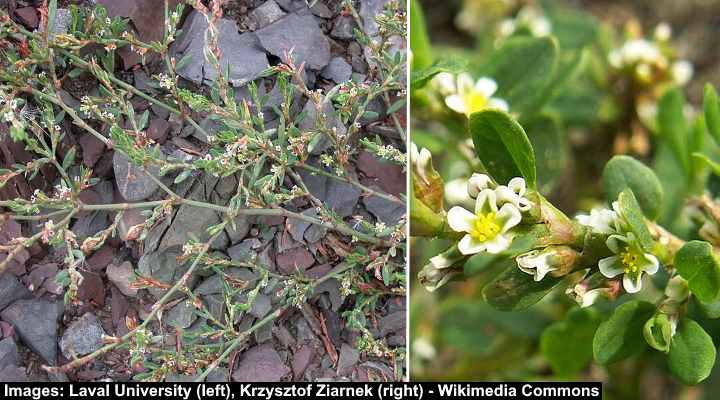
The prostrate knotweed spreads quickly on the ground and has white or pinkish tiny flowers
Prostrate knotweed is a low-growing annual weed with clusters of small white flowers, sometimes with pink margins. The characteristics of the weed are its small, round, lanceolate stalkless leaves, semi-erect stems, and dark brown, three-edged nuts. Its prostrate growth forms a dense mat-like ground cover and can spread quickly.
Prostrate knotweed grows 4” to 16” (10 – 40 cm) tall. It tolerates dry, compacted soils, making it a common weed in areas with poor soil conditions. Also, the seeds can remain dormant for years, making it a common weed in disturbed areas.
Other names for the weed include common knotgrass, pigweed, lowgrass, and birdweed.
Wild Radish (Raphanus raphanistrum)

The wild radish is an edible weed with delicate white or yellow flowers
Wild radish is a flowering weed with unusual white flowers, spatula-shaped petals, and prominent veining patterns. This common weed can also produce white or yellow flowers. Wild radish has lobed leaves growing in a basal rosette pattern, similar to dandelion leaves. The weed grows up to 2.5” (0.75 m) tall.
Wild radish is a fast-growing plant that spreads quickly and becomes invasive if left unchecked. However, wild radish has some beneficial uses. Its leaves, flowers, and seed pods are edible and have a spicy taste like mustard or horseradish.
Carolina Horsenettle (Solanum carolinense)

The Carolina horsenettle is a perennial weedy plant with white flowers that spreads easily
Carolina horsenettle weeds have white, star-shaped flowers that bloom in summer and fall. This native perennial plant has weed-like tendencies as it spreads rapidly through its rhizomes and seeds. Carolina horsenettle has prickly stems, dull green oblong leaves, and green berries resembling small tomatoes. The weed grows up to 4 feet (1.2 m) tall.
Native to North America, Carolina horsenettle is a noxious weed competing with crops and cultivated plants for resources. Additionally, all parts of the plant are toxic and are poisonous if ingested. Therefore, wearing protective clothing is vital when removing this weedy plant from your yard.
Virginia Buttonweed (Diodia virginiana)
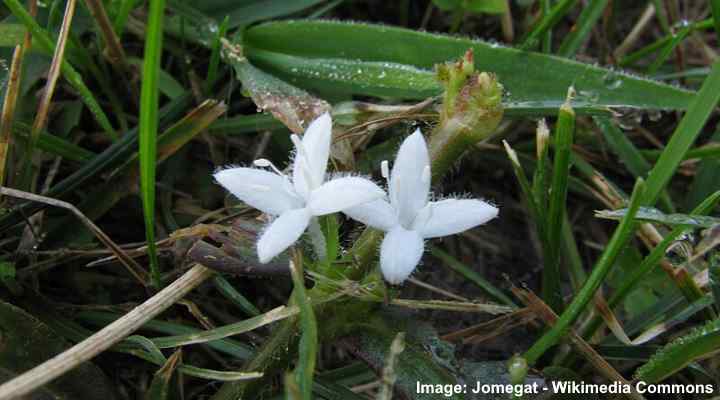
The Virginia buttonweed is a low growing perennial lawn weed with small white flowers
Virginia buttonweed is a pervasive weed found in lawns and turfgrass, particularly in the southeastern United States. This low-growing perennial weed has delicate small white flowers with four distinct petals. These button-like flowers give the plant its common name, blooming from late spring to early fall, adding a touch of subtle elegance to the otherwise problematic weed.
Virginia buttonweed forms dense mats close to the ground, with its small, dark green, smooth-edged leaves growing in opposite pairs along the stems. This weed thrives in moist, poorly-drained lawns and is difficult to control. The invasive white-flowering weed tolerates mowing and grows in heavy foot traffic areas. Virginia buttonweed is often considered a nuisance and can be challenging to remove from lawns and gardens.
Maintaining a healthy lawn and garden is crucial to get rid of the white flowers from your grass. Regular mowing and proper watering can help prevent the weeds from spreading through your lawn.
Purple Flowering Weeds (with Pictures) – Identification
Purple flowering weeds are a common sight in the spring. While some may be invasive, all of them are pretty and relatively easy to identify. Please read on to discover what weeds with purple flowers could affect your garden.
Canada Thistle (Cirsium arvense)
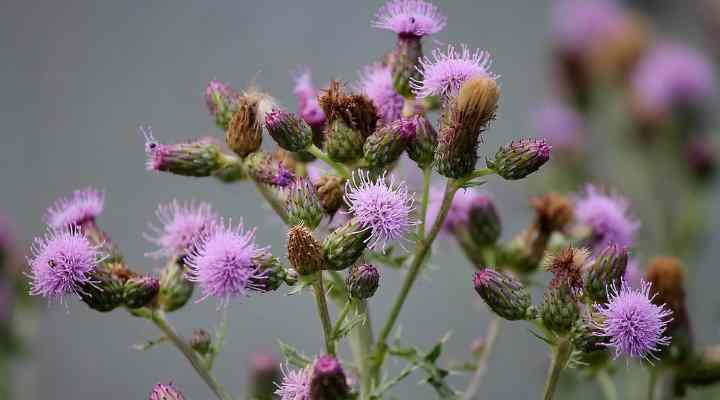
Creeping thistle is a very invasive weed with purple flowers and extensive root system
Canada thistle is a common purple lawn weed that produces clusters of up to five purple flower heads on a stem. Together, there can be over 100 flower heads per shoot. The weedy growth from creeping thistle comes from its thickened roots that produce numerous shoots per season.
Many horticulturists consider Canada thistle the most invasive weed in the world. The purple-flowering noxious weedy plant has invasive horizontal and vertical roots that create an extensive system. Also named creeping thistle, the flowering weed has pinkish-purple flowers and sparse leaves on wiry green stems. This weed with purple flowers grows up to 5 ft. (1.5 m) tall.
Alternative names for Canada thistle explain its weedy nature. For example, curses thistle, lettuce from hell, prickly thistle, and stinger needles are some common names for Cirsium arvense.
Chicory (Cichorium intybus)
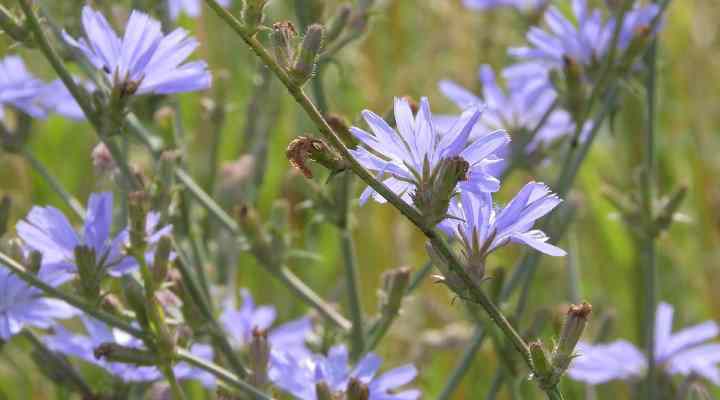
Chicory is not as invasive as other weeds and have pretty purple flowers
Chicory is a non-native flowering weedy plant with purple or pale blue flowers. Chicory is identified by its flowers with purple petals radiating in a fan shape from the center. The edible herbaceous plants have lance-shaped hairy leaves, pretty bluish-purple flowers, and tough taproots.
Chicory plants grow 3 to 4 ft. (1 – 1.2 m) tall and up to 2 ft. (0.6 m) wide. Although the purple-flowering plant has weed-like growth, it’s not as invasive as other weeds. Chicory commonly grows in waste areas, along roadsides, and in pastures.
The most common use of chicory as a beneficial herb is to dry its edible taproots to use as a coffee substitute.
Morning Glory (Ipomoea purpurea)
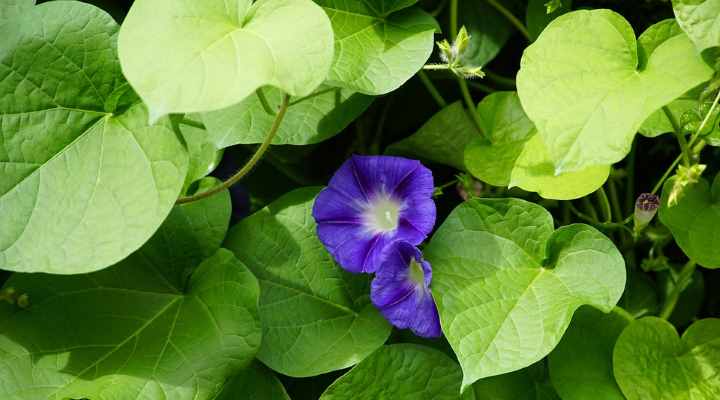
The fast growing morning glory vines spread quickly and are considered perennials in warmer climates and annuals in colder climates
Morning glory is a rapidly spreading vining plant with stunning trumpet-shaped purple flowers. The vine’s weedy growth comes from its ability to spread rapidly. It forms a mat of green foliage and purple, blue, or white flowers that bloom in the morning from summer through fall. Morning glory leaves are heart-shaped and can add a touch of greenery to any garden.
Morning Glory is a fast-growing vine that can grow 6 to 10 ft. (1.8 – 3 m) in a single season. Although it is useful as ground cover or to cover fences, trellises, or arbors, it can be invasive. Morning glory thrives in full sun and well-drained soil, and it is relatively low-maintenance.
Greater Burdock (Arctium lappa)
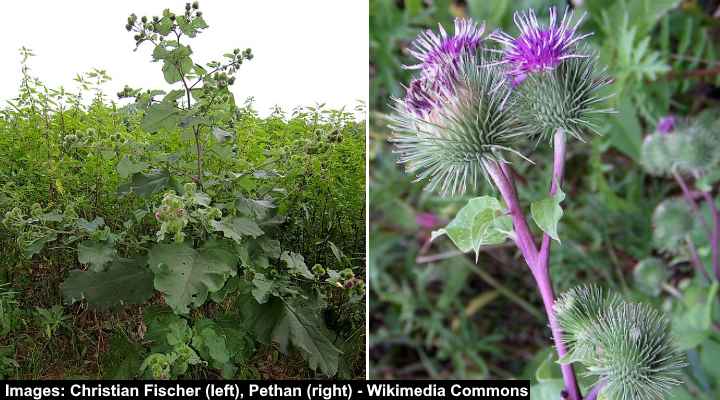
The greater burdock weed has round spiky flowers with purple tops and can grow very tall
Greater burdock is a highly invasive weed with purple flowers. Also called beggar’s buttons, thorny bur, or happy major, the weedy plant is known for its large leaves with wavy edges, prickly burrs, and spiky globular flowers with purple crowns. The large weed grows up to 10 ft. (3 m) tall. Its purple or pink flowers bloom in the summer.
Greater burdock is an annoying weed due to its prickly burs that stick to clothing and animal fur. Also, short, fuzzy hairs detach easily from the plant and are carried in the wind. These affect people when they land on the eyes, mucous membranes, and the skin, causing severe skin irritation.
Despite its weedy nature, greater burdock has several culinary uses. Its large 3 ft. (1 m) edible deep taproot has a mild, intense flavor and is used like carrots. Also, its edible leaf stalks are peeled and eaten cooked or raw.
Purple Loosestrife (Lythrum salicaria)
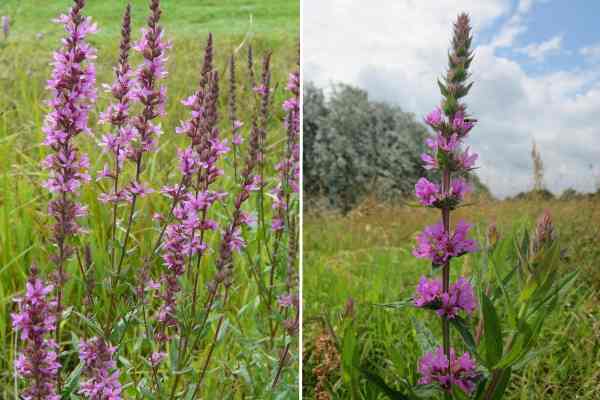
Purple loosestrife is an invasive weed with tall spikes of purple-pinkish flowers
Purple loosestrife is a noxious, weedy perennial plant that creates a carpet of purple or pink flowers in fields and along roadsides. This purple-flowering invasive weed competes with native plants and wildlife for resources. Despite its attractive tall spikes of purple flowers, the plant disrupts waterways and food supply for native wildlife.
Purple loosestrife blooms in the summer and can grow up to 4 to 9 ft. (1.2 to 2.7 m) tall. The invasive weed spreads quickly through its underground rhizomes, choking the roots of native plants. To eradicate the purple weed, digging up its roots and destroying the plant before it seeds is vital.
Purple loosestrife is a hardy plant that tolerates a wide range of soil conditions. However, it performs best in moist, wet soil where it thrives in full sun or partial shade.
Purple Flowering Weeds in Lawn (with Pictures) – Identification
Purple flowering weeds in lawns are a common sight, especially during summer. But, by the end of the season, these weeds can be overtaking your lawn. Here are some weeds with purple flowers that can infest turfgrass.
Creeping Charlie, Ground Ivy (Glechoma hederacea)
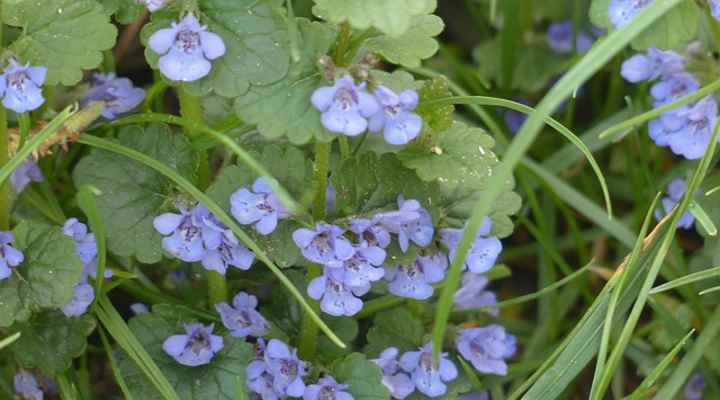
Creeping Charlie is a spreading lawn weed with small purple flowers
Creeping Charlie or ground ivy is a weedy, creeping lawn weed with heart-shaped leaves and purple flowers. Creeping Charlie commonly invades lawns and can quickly take them over. But, very soon, lawns infested with creeping Charlie can become a matted carpet of small trumpet-shaped flowers and fan-shaped leaves.
Creeping Charlie typically grows up to 1 ft. (0.3 m) tall. After blooming, the stems droop to the ground and spread to 2.4 ft. (0.76 m) wide. The issue with this purple-flowering lawn weed is that it survives mowing and continues to thrive and take over turfgrass.
Common Blue Violet (Viola sororia)
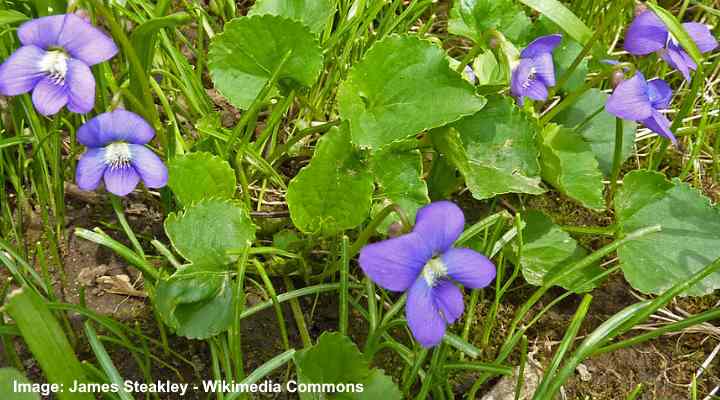
The low growing purple flowering wild violet spreads quickly through the lawn
Common blue violet is a purple flowering weed that can self-seed in lawns and hence is considered as an undesirable wildflower. Blue violets spread quickly in yards due to their horizontally spreading roots and fast growth. The lawn weed is identified by its five-petalled purple flowers with white throats and heart-shaped leaves.
Some gardeners view blue violet plants as useful lawn and garden plants for enhancing a landscape. However, suppose you want blue violets to flourish in a lawn. In that case, reducing nitrogen fertilization and keeping the lawn shaded is vital.
Selfheal (Prunella vulgaris)
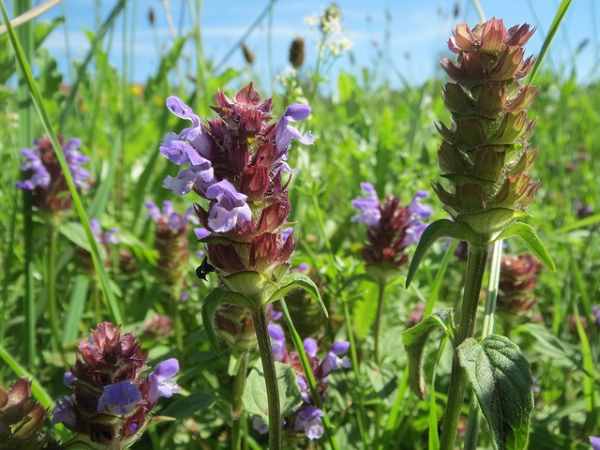
Common self-heal is a ground cover perennial weed with purple flower spikes
Selfheal is a purple flowering weedy plant that can infest lawns. The creeping perennial weed produces erect spikes of purple tubular flowers, blooming from spring through summer until fall. The ground-spreading plant has lanceolate, serrated leaves. It grows 1 to 2 ft. (0.3 – 0.6 m) tall and up to 9” (22 cm) wide.
Selfheal can become a problem in lawns that have full sun to partial shade exposure.
However, its weedy growth means the purple-flowering plant has uses as evergreen ground cover or erosion control. It forms a dense mat of green leaves and purple flowers.
Common Henbit (Lamium amplexicaule)
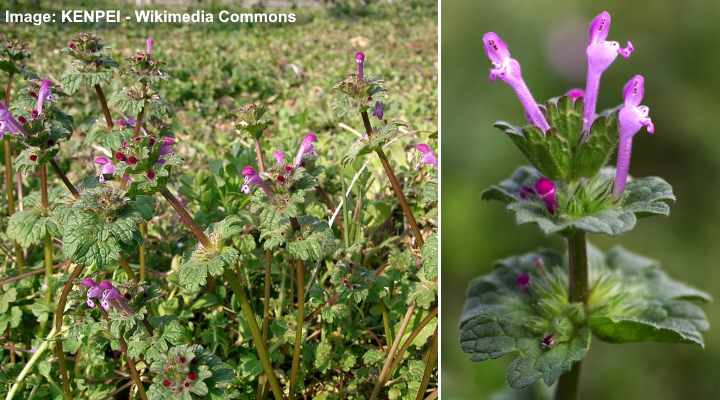
Henbit is an annual weed with pink to purple flowers that can be used as a ground cover for erosion control
Also called deadnettle, common henbit is a common annual weed with attractive purple-pinkish tubular flowers. The identifying features of the herbaceous weed are its heart-shaped leaves with scalloped edges, terminal clusters of pink to purple flowers, and egg-shaped seed capsules. Common henbit grows up to 16” (40 cm) tall.
Although considered a weedy plant, common henbit can also be useful as purple-flowering ground cover for erosion control. Also, its tubular nectar-rich flowers attract hummingbirds and bees to wildflower gardens. It is a hardy plant that can tolerate a variety of soil conditions and can spread quickly if not controlled.
Purple Deadnettle (Lamium purpureum)
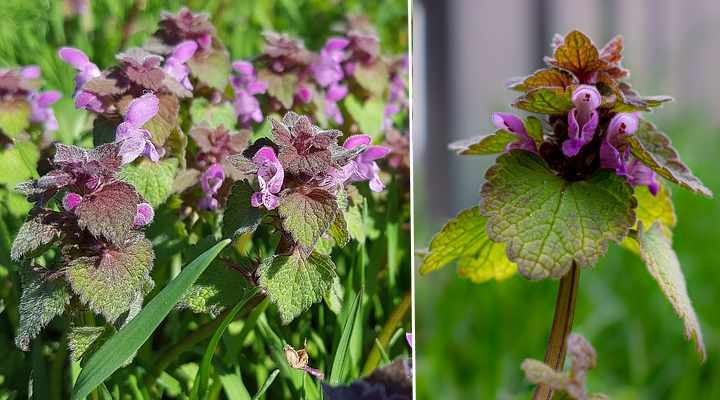
Purple deadnettle is a common weed that can be also used as a low maintenance ground cover
Purple deadnettle is a common purple-flowering lawn weed that can grow as ground cover or an ornamental plant. The freely-spreading plant has clusters of purple flowers and heart-shaped, scalloped leaves with a purplish tinge. The plant’s square stems grow 2” to 8” (5 – 20 cm) tall.
Purple deadnettle is a common weed throughout the US. You often find the weedy plant growing in lawns, gardens, roadsides, and waste areas. Although considered a noxious weed, it’s a useful flowering plant for early-season nectar production to attract bees and other pollinators.
Purple Deadnettle is a hardy plant that can tolerate various soil conditions and does not require much maintenance. Despite its common name, Lamium purpureum is not a true nettle and doesn’t sting.
Types of Pink Flowering Weeds (with Pictures) – Identification
Common Thistle (Cirsium vulgare)
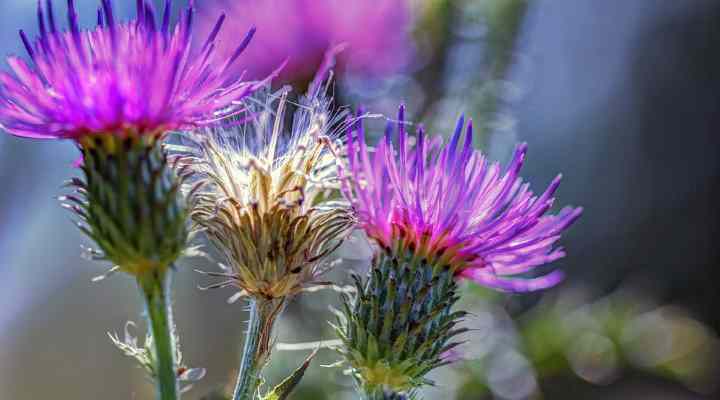
The pink flowering common thistle is invasive weed in some areas and can affect native plants
Also called spear thistle, this weed is identified by its pinkish-purple flowers, gray-green spiny leaves, and erect stems growing 3 to 5 ft. (1 – 1.5 m) tall. The weedy nature of common thistles means they form dense thickets, crowding out native plants. This weed-like growth can impact foraging in pasture areas due to its spiny, jaggy leaves.
Pink thistle flowers have disc florets that are long tubular, forming a colorful crown on a greenish spiny ball. The long 7-inch (17 cm) leaves are deeply lobed and contain spines.
Field bindweed (Convolvulus arvensis)
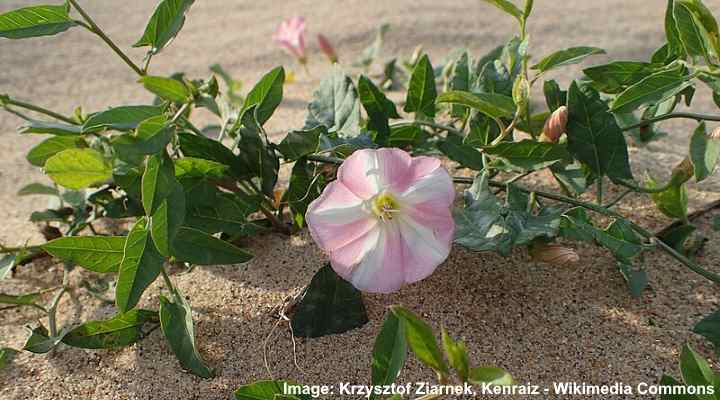
The pink and white flowering field bindweed is considered a weed in some places as it spreads quickly
Field bindweed is a creeping or climbing vine with trumpet-shaped pink and white flowers. Considered a weed in many areas, the rhizomatous spreading plant quickly spreads and takes over gardens, making it difficult to control. The weed grows 1.5 to 6.5 ft. (0.5 – 2 m) in length.
Field bindweed is a troublesome weed because it’s adaptable to various soil conditions. Although it performs well as a ground cover plant for sun or shade, it can quickly get out of control. It can twine around other plants and structures, often choking them out. Also, the weed can appear as if from nowhere because its seeds remain viable for many years.
Mallow (Malva neglecta)
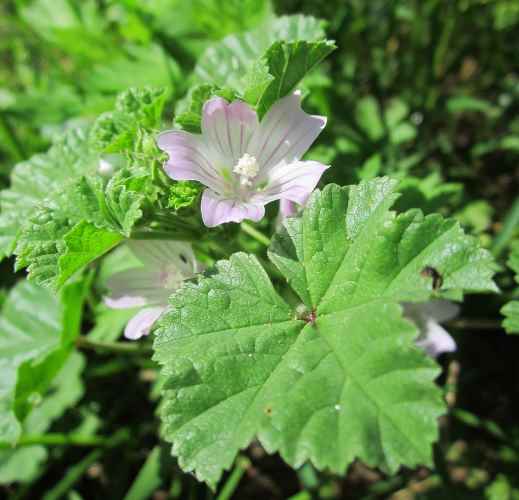
Mallow vines have pale pink flowers and has an invasive nature
Also called buttonweed, cheeseweed, mallow is an invasive weed that creates a thick mat of green foliage, choking out other plants. The weedy plant is identified by its five-petalled light pink flowers with lobed petals arranged in clusters at the top of the plant. Its fuzzy silver-gray leaves have a velvety feel and are deeply dissected.
Mallow is a hardy plant that can become a nuisance in yards in USDA zones 4 to 8. It thrives in most soil conditions in full sun or partial shade. If you plant the vigorous vine to add color to a fence, arbor, or trellis, ensure it doesn’t spread. This plant can grow up to 2 ft. (0.6 cm) tall.
Lady’s Thumb (Polygonum persicaria or Persicaria maculosa)
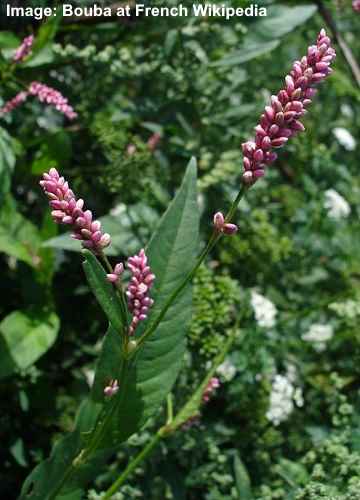
The pink flowering lady’s thumb spreads easily through its numerous seeds
Lady’s thumb is a common annual weed with tiny pink flowers that bloom from July through September. The small tubular pink flowers consist of four or five petals fused at the base and growing on flowering spikes. The weedy plant has narrowly ovate leaves and a bushy, mounding habit.
Also called redshank, lady’s thumb grows up to 3 ft. (1 m) tall and spreads rapidly through its ability to produce numerous seeds. Its invasive nature has made it a pesky weed throughout North America. Like many introduced species, lady’s thumb outcompetes native plants if left unchecked.
Its tolerance for damp, soggy soils means it commonly grows in seasonal water basins and along the edges of lakes and rivers.
Joe-Pye Weed (Eutrochium spp.)
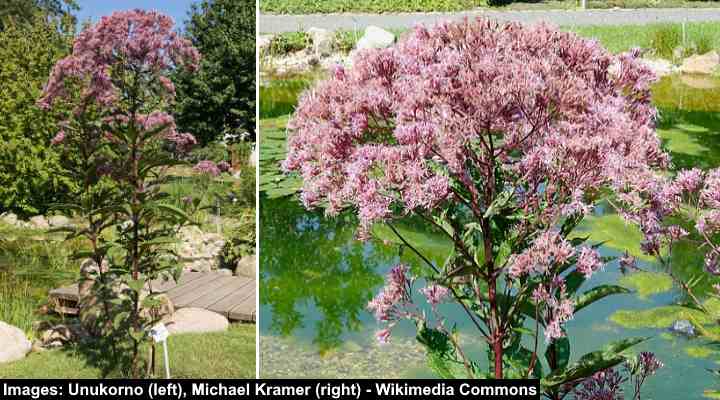
In the picture: Purple Joe-pye weed (Eutrochium purpureum)
Joe-pye weed has large clusters of pink or purple flowers that bloom in late summer and early fall. Although considered an ornamental flower, its weedy growth comes from its vigorous rhizomatous roots that spread aggressively. The plant has lanceolate leaves growing in whorls on upright stems.
Joe-pye weed grows 4 to 7 ft. (1.2 – 2.1 m) tall. Its dome-shaped clusters of pink, nectar-rich flowers attract pollinators to wildflower gardens. Also, it thrives in wet areas of gardens where other plants may struggle. However, in some landscapes, its aggressive growth outcompetes cultivated plants.
Another feature of Joe-pye weed’s invasive nature is its seed production. The hundreds of tiny flowers produce masses of seed in the fall that get dispersed by the wind. Also, its tall stature can overshadow other plants, making it a problematic flowering plant in small gardens.
Types of Pink Flowering Weeds in Lawn (With Pictures) – Identification
Red Clover (Trifolium pratense)
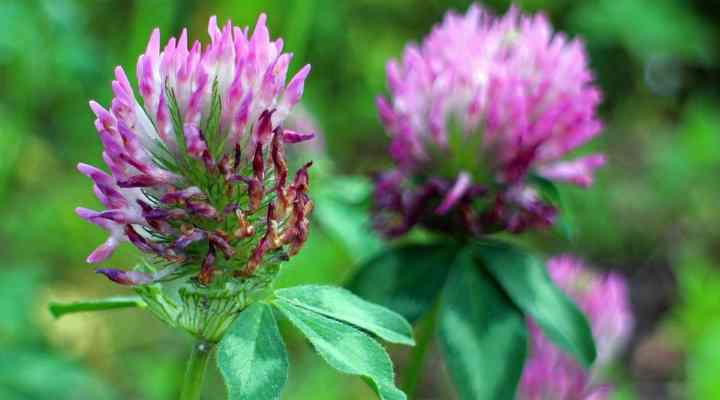
The low growing red clover has pink flowers and is a common weed in many lawns
Red clover is a common lawn weed with pink flowers. The perennial low-growing spreading plant has slender stalks, small oblong leaves, and rose-pink rounded flowers growing at the end of stems. The weedy plant can spoil the appearance of lawns due to its clumping nature, pink flowers, and fuzzy broadleaves.
Despite its name, red clover produces pinkish flowers, not deep red flowers. And the weedy plant blooms from spring through fall.
Red clover has beneficial uses despite being classed as a pink-flowering lawn weed. It is ideal for soil improvement to boost nitrogen levels and attract pollinators to gardens.
Yellow Flowering Weeds
Dandelion (Taraxacum officinale)
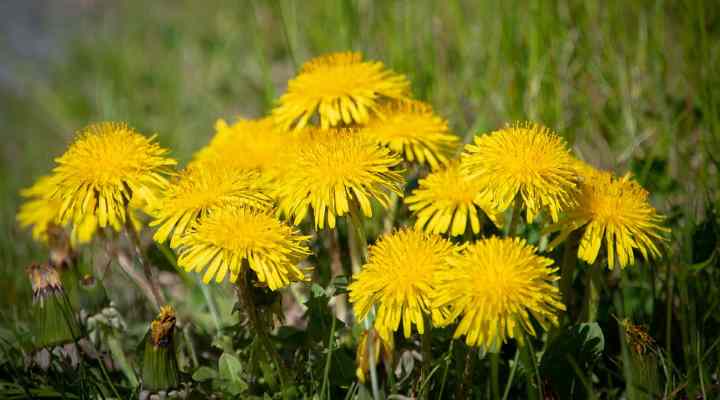
The yellow flowering dandelion is a common lawn weed with a deep taproot
Dandelion is a yellow-flowering weed that can impact the appearance of a well-kept lawn. Dandelion’s weedy growth comes from its deep taproots that are difficult to remove. As a result, the plant grows vigorously in lawns, covering them with yellow flowers. Dandelion is identified by its deeply lobed leaves and golden yellow disc-shaped flowers.
Creeping Buttercup (Ranunculus repens)
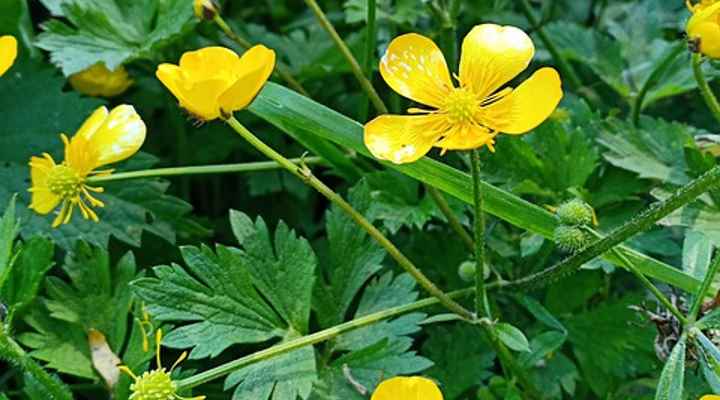
Creeping buttercup is a fast growing yellow flowering ground cover plant that can become a lawn weed
As the name suggests, creeping buttercup is a spreading plant with yellow flowers that can become a weed issue in lawns. Buttercups spread through stoloniferous (creeping) roots. The ground-running stems produce stems with finely hairy, dark green leaves and golden yellow, five-petaled flowers.
Purslane (Portulaca oleracea)
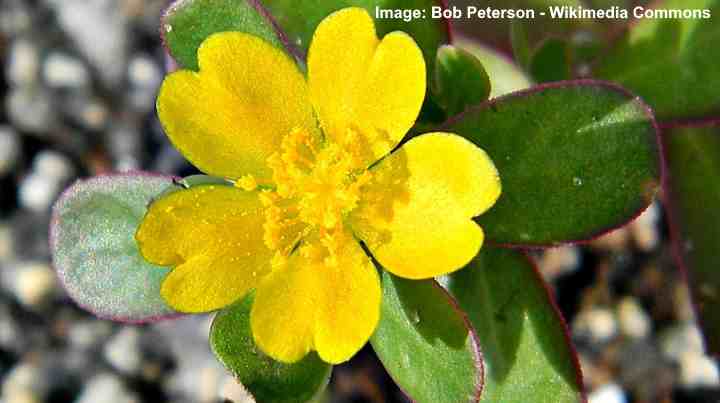
Portulaca oleracea is a weedy succulent with yellow flowers
Purslane is a weedy plant with succulent leaves, red stems, and yellow cup-shaped flowers with four lobed petals. Also called hogweed, pigweed, or pursley, this spreading plant has taproots and fibrous secondary roots. The small yellow flowers are identified by their five heart-shaped petals and clusters of spoon-shaped green leaves.
Yellowwood sorrel (Oxalis stricta)
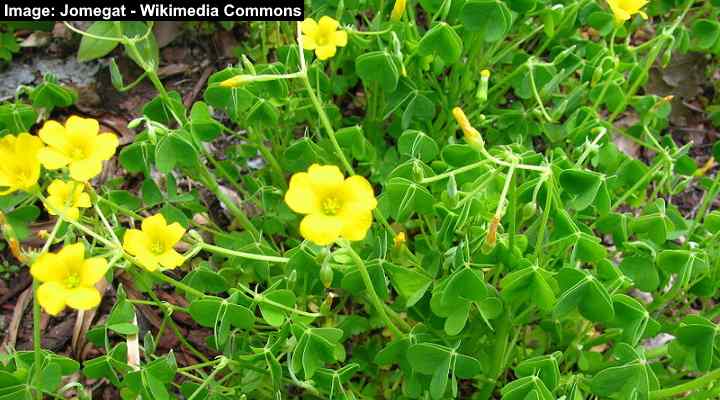
Yellow woodsorrel is a lawn weed with bright yellow flowers and heart-shaped leaves
Yellowwood sorrel is a yellow-flowering plant with invasive tendencies and the potential to disrupt flower beds and lawns. Its bright yellow flowers have five petals and resemble small buttercups. Blooming from spring to fall, the fast-growing plant can cover lawns in yellow flowers. The weedy plant has clover-like leaves with three heart-shaped leaflets.
Yellowwood sorrel tolerates drought and direct sunlight. In ideal conditions, the ground-hugging lawn weed grows 4” to 12” (10 – 30 cm) tall. The pesky weed spreads through a network of underground roots. Also, its ribbed, elongated seed capsules burst open, shooting tiny brown seeds up to 3 ft. (1 m) away.
Yellowwood sorrel can plague well-manicured lawns. Despite its attractive yellow flowers, the spreading weed competes with other plants for nutrients and space.
Yellow Rocket (Barbarea vulgaris)
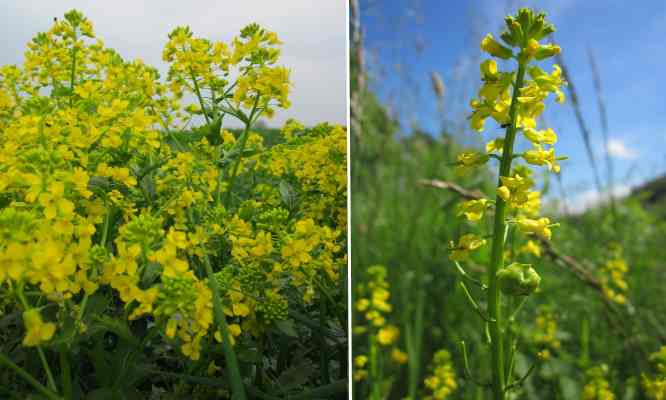
Yellow rocket is an edible weed with scented yellow flowers that attract pollinators
Yellow rocket is identified by its clusters of small yellow four-petaled flowers on show in spring and summer. Other features of the weedy plant are its deeply lobed green leaves and clusters of fragrant yellow flowers at the end of short stems. Its robust taproot and prolific seed production can make it difficult to control in landscapes.
Yellow rocket grows 1 to 2 ft. (0.3 – 0.6 m) tall. Its mounding growth forms dense thickets that compete with desirable plants for nutrients.
However, the yellow rocket has some redeeming qualities. For example, its sweetly scented yellow flowers attract pollinators like bees and butterflies. Also, its edible leaves have a sharp, mustard-like taste and are commonly used in salads. Despite its weedy growth, it’s not difficult to control in backyards.
Velvetleaf (Abutilon theophrasti)
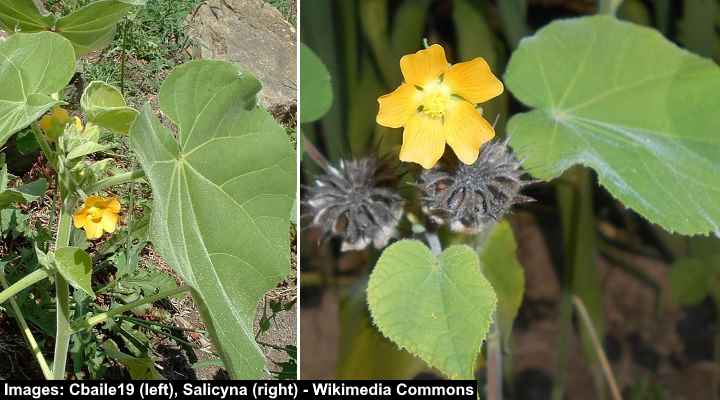
The yellow flowering velvetleaf can quickly colonize fields and competes with native crops
Velvetleaf is an annual weed characterized by its yellow flowers, tall, branched stems, and large heart-shaped leaves with wavy margins and pointed tips. The weed’s yellow flowers measure 1” to 2” (2.5 – 5 cm) in diameter, and its leaves are 3” to 8” (7.5 – 20 cm) long.
Native to Asia, velvetleaf has invasive tendencies and can quickly colonize fields. The tall, weedy plant grows 3 to 8 ft. (1 – 2.4 m) tall. It spreads through its numerous seeds contained in seed pods covered in velvety hairs. Velvetleaf outcompetes local crops, and its tall growth reduces light penetration for smaller, desirable crops.
Also, yellow-flowering velvetleaf releases chemicals into the soil that inhibit the germination of native crops. Controlling velvetleaf can be challenging, as it is resistant to many common herbicides. Therefore, hand-pulling or hoeing are the most effective control methods in small areas.
Black Medic (Medicago lupulina)
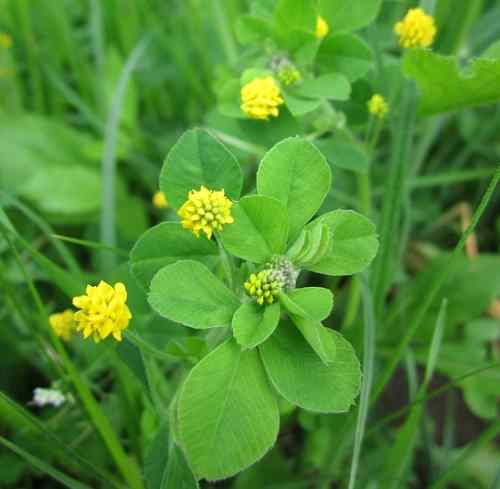
The yellow flowering black medic is a lawn weed with a deep taproot
Black medic is a low-growing annual lawn weed identified by its small yellow flowers and trifoliate leaves. Black medic tends to grow where it’s not wanted. The globe-shaped yellow flowers, clover-like leaves, and aggressive seeding can disrupt garden landscapes. Also, its deep taproot makes complete removal challenging.
Black Medic grows 6” to 18” (15 – 45 cm) tall, forming a dense mat of foliage and yellow flowers. After flowering, black medic forms small, coiled, and twisted seed pods containing numerous seeds. Although invasive, the weedy mat-forming plant attracts pollinators such as bees and butterflies with its nectar-rich flowers.
Controlling black medic can be challenging. It spreads aggressively by seed, and its taproot regrows if not completely removed. Regular mowing and proper lawn maintenance can help to prevent black medic from spoiling a lawn’s appearance.
Yellow Salsify (Tragopogon dubius)
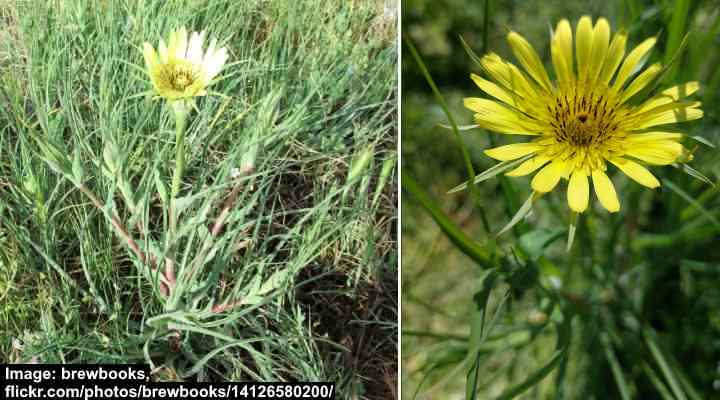
Yellow salsify weeds grows in poor soil and are drought tolerant
Yellow salsify is known for its bright yellow star-shaped flowers. The yellow ray flowers have numerous thin petals surrounding a central disc. Blooming in spring, the weedy plant has blue-green linear, grass-like leaves. In fall, the flowers go to seed and develop large, fluffy, dandelion-like puff seed heads.
Yellow salsify grows up to 2 ft. (0.6 m) tall. The plant’s weedy nature is due to its deep taproot, making it difficult to eradicate. Also, its fluffy seeds, with their parachute-like structure, travel long distances in the wind. In addition, the yellow weed is drought-tolerant and thrives in poor soil conditions.
Yellow salsify may have pretty yellow flowers. However, its ability to colonize new areas rapidly, including lawns and flower beds, makes it weedy. It can also outcompete desirable grasses and plants in some climates.
Cutleaf Evening Primrose (Oenothera laciniata)

Cutleaf evening primrose is a low growing yellow flowering weed
Cutleaf evening primrose is a weedy plant with pretty yellow flowers growing on low-spreading stems. The yellow buttercup-like flowers contrast nicely with the plant’s deeply lobed leaves. These grow on prostrate stems that form dense mats on the ground. A unique feature of the flowers is when they bloom in the evening and close during the day.
Cutleaf evening primrose forms colonies without much effort, making it difficult to control in landscapes. The ground-hugging plant grows 6” to 24” (15 – 60 cm) tall and thrives in dry, rocky, and sandy soils. It prefers full sun but can tolerate some shade.
This evening primrose variety can spread aggressively in gardens, potentially outcompeting desired plants and spoiling the appearance of lawns. Additionally, seeds are easily dispersed by wind, contributing to their spread.
Bristly Oxtongue (Helminthotheca echioides)
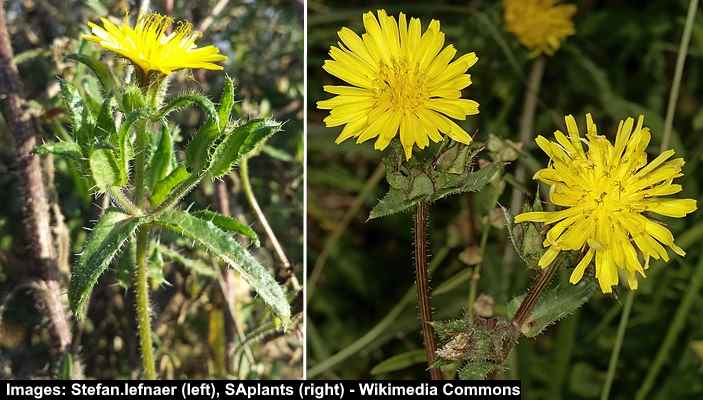
The yellow flowers of the bristly oxtongue resemble those of dandelions
Bristly or prickly oxtongue is a yellow-flowering weed that looks like dandelions. The noxious weed has yellow ray-like flowers 1.4” (3.5 cm) wide atop hairy stems. The weedy foliage consists of bristly leaves growing in a basal rosette pattern and yellow flowers. The lance-shaped leaves have a round texture with a bumpy, fuzzy appearance.
Bristly oxtongue is considered a weed because of its rapid, uncontrolled, invasive growth. The flowering stems grow up to 3 ft. (1 m) tall, and the tough, spiny leaves are 8” (20 cm) long. Bristly oxtongue develops large fluffy seed heads like dandelions. These allow the plant to colonize new areas rapidly, contributing to its spread and persistence as a pesky weed.
The best way to eradicate bristly oxtongue weeds is to pull them by hand, ensuring the removal of the entire root system. Wear gloves to protect your hands from the bristly hairs on the plant. Mowing lawns before the plant reaches the flowering stage can prevent seed production.
Orange Flowering Weeds
Orange Jewelweed (Impatiens capensis)
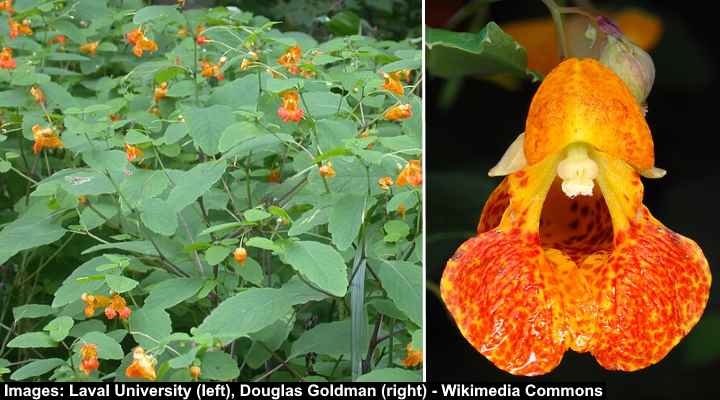
Orange Jewelweed (Impatiens capensis)
Orange jewelweed is an orange-flowering plant exhibiting weed-like characteristics, spreading rapidly in landscapes. It is known for its nodding, vibrant orange spur-shaped flowers with distinct dark orange and reddish spots. The plant has lance-shaped leaves with toothed margins. It grows 3 to 5 ft. (0.9 – 1.5 m) tall and 1 to 2 ft. (0.3 – 0.6 m) wide.
Also called spotted touch-me-not, this weedy plant grows best in boggy or marshy areas. The weed thrives in partial to deep shade, meaning it thrives as an understory weed. Despite its weedy tendencies, the orange blooms attract hummingbirds and butterflies with their nectar-rich flowers.
Orange jewelweed also spreads via its seeds. The plant’s seed capsules have a unique dispersal mechanism—they burst open when touched or disturbed.
Blue Flowering Weeds
Asiatic Dayflower (Commelina communis)
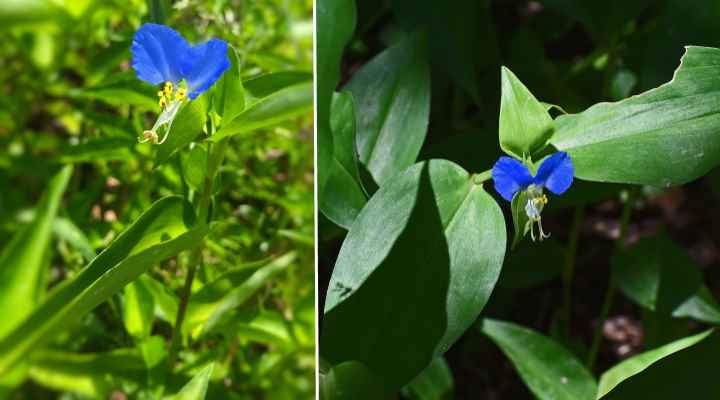
Asiatic Dayflower (Commelina communis)
Dayflower is one of the prettiest blue-flowering noxious weeds. The eye-catching blue flowers bloom in summer. They have two deep blue petals and one smaller white petal with extended yellow, hooked stamens. Its stalkless leaves are lance-shaped, smooth, bright green, and attached to reddish stems.
As the name suggests, the delicate blue flowers only last a day. However, they have a long blooming time from summer through fall. Despite the beauty of the orchid-like flowers, Asiatic dayflowers are highly invasive. They spread easily in non-native landscapes, competing with desirable native plants for resources.
Dayflower thrives in moist, well-draining soil and tolerates full sun or partial shade. The weedy plant grows 1 to 3 ft. (0.3 – 1) m and has a spreading habit.
Other Colors of Flowering Weeds
Broadleaf Plantain (Plantago major)
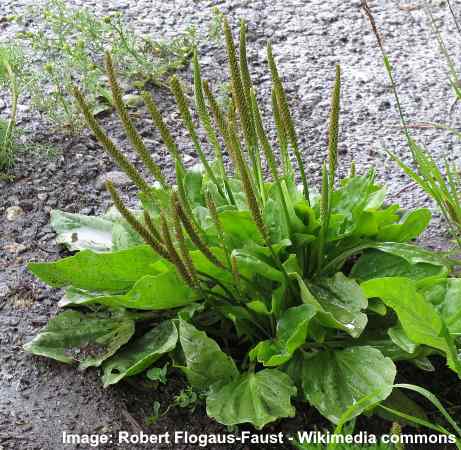
Broadleaf Plantain (Plantago major)
Broadleaf plantain is a common weed characterized by its tall, slender green flower spikes and large oval leaves. The weedy plant grows 4” to 12” (10 – 30 cm), and its oval leaves grow 8” (20 cm) long and 3.5” (9 cm) wide. The tall spikes are densely covered with small flowers, reaching above the height of the leaves.
Broadleaf plantain is often considered a nuisance weed because it can quickly spread and take over an area. It can become a nuisance in lawns where its basal rosette of large leaves spoils the turfgrass’s appearance. The best way to remove the weed is to dig it out by hand.
You can also try using household vinegar or boiling water to kill the plants. However, you must be careful to avoid damaging desirable plants close by. Additionally, broadleaf plantain thrives in poor, compacted soil. Therefore, improving soil quality or turfgrass health can help to discourage weed growth.
Broad-Leaved Dock (Rumex obtusifolius)
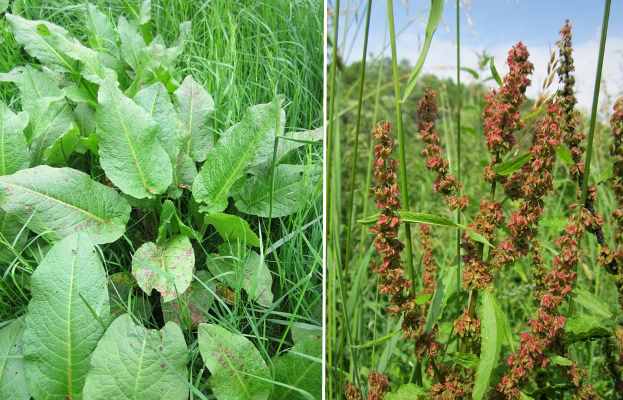
Broad-Leaved Dock (Rumex obtusifolius)
Broad-leaved dock is a common weed found in lawns and gardens. This plant is identified by clusters of tiny greenish flowers that turn red and broad, oval-shaped leaves that grow in a rosette pattern. The large leaves, with their red stalks and veins, can grow up to 12” (30 cm) long and 6” (15 cm) wide.
Also called bitter dock or bluntleaf dock, the weed produces tall flower stalks with small, greenish-white or red flowers that bloom in the summer. The flowers are followed by small seed capsules that contain numerous tiny seeds. This plant is often considered a weed because it grows in unwanted places without planting. It also quickly colonizes bare or disturbed soil.
Broad-leaved dock weeds feature a deep and extensive taproot. The weedy plant’s network of roots makes it challenging to eradicate once established. Digging out the entire root system is necessary to prevent it from returning.
Poison Ivy (Toxicodendron radicans and Toxicodendron rydbergii)
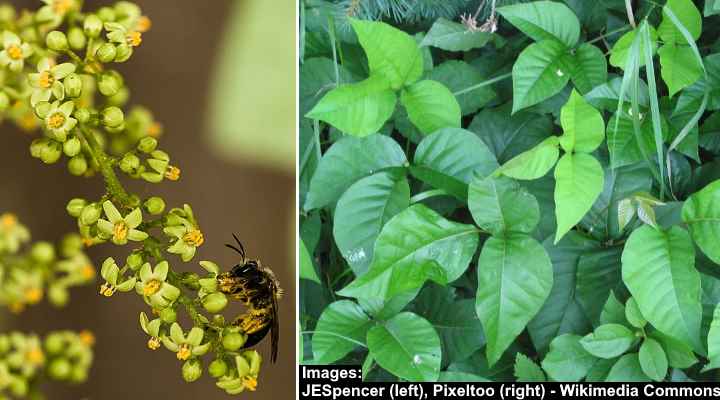
In the picture: The eastern poison ivy (Toxicodendron radicans)
Poison ivy is one of the worst weeds in a garden. This poisonous group of unwelcome weeds has leaves containing an irritating toxic compound. The toxic weed has small clusters of greenish flowers blooming throughout summer. Its leaves are often lance-shaped or egg-shaped and grow in groups of three. The noxious weeds typically grow as low shrubs or vines.
Poison Ivy is considered a weed due to the skin irritation it causes. Contact with the leaves can cause nasty skin reactions like blistering, redness, inflammation, and itching. The plant’s toxic compounds remain active even though the vines or leaves are dead.
Poison ivy has eye-catching foliage in the fall, with its leaves turning brilliant red or orange shades.
Pigweed (Amaranthus retroflexus)
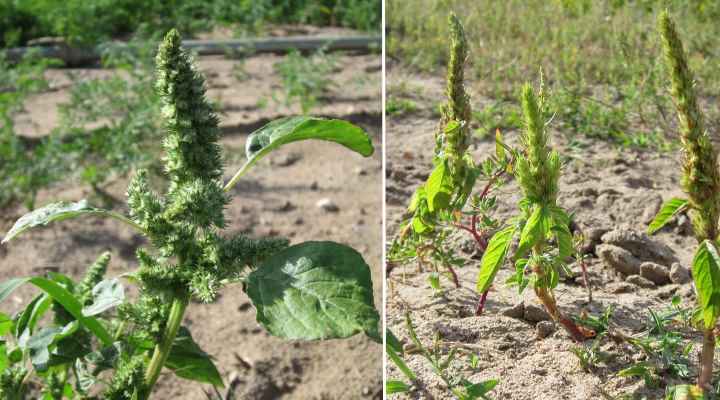
Pigweed (Amaranthus retroflexus)
Pigweed is a common annual weed with dense clusters of flowers growing in small spikes. The weedy plant is known for its large, lance, or heart-shaped leaves with reddish or purple veins. In the fall, the deciduous leaves turn eye-catching burgundy and red colors. The greenish flowering panicles give way to dark brown seeds in the fall.
Pigweed can be invasive in gardens, lawns, and agricultural fields. The plant can grow 10 ft. (3 m) tall, and its large leaves are 6” (15 cm) long. It’s a highly adaptable plant and tolerates various inhospitable soil conditions—part of the reason it’s a pesky weed. If left unchecked, it quickly colonizes areas, competing with cultivated plants for nutrients and water.
Controlling pigweed can be challenging. It produces many seeds—sometimes over 100,000 per plant, and they can remain viable in the soil for several years. Therefore, preventing pigweed from being established is crucial. Regular weeding and manually hand-pulling the weed can help to eradicate it.
Frequently Asked Question About Flowering Weeds
Are all flowering weeds harmful to my garden?
No, not all flowering weeds are harmful to your garden. Some, like daisies and sunflowers, can enhance its beauty and provide nectar for pollinators. Others, like clover, even benefit nearby plants by fixing nitrogen in the soil. However, invasive weeds like bindweed and thistle can be detrimental as they compete with cultivated plants for resources.
Can flowering weeds coexist with my cultivated plants?
Flowering weeds can coexist with cultivated plants to some extent, but they may also compete for nutrients, water, and sunlight. It’s important to manage them to prevent them from overwhelming your garden.
How can I prevent weed infestations without using chemical herbicides?
To prevent weed infestations without chemical herbicides, you can use mulch, manual weeding, and regular cultivation to disrupt weed growth. Planting cover crops, practicing crop rotation, and maintaining healthy soil can also help. Another option is to use homemade herbicides that are safe, natural, and non toxic.
Are there any flowering weeds that are beneficial to pollinators?
Yes, some flowering weeds are beneficial to pollinators. Plants like clover, dandelion, and wildflowers can provide essential nectar and pollen sources for bees, butterflies, and other pollinating insects.
Related articles:
